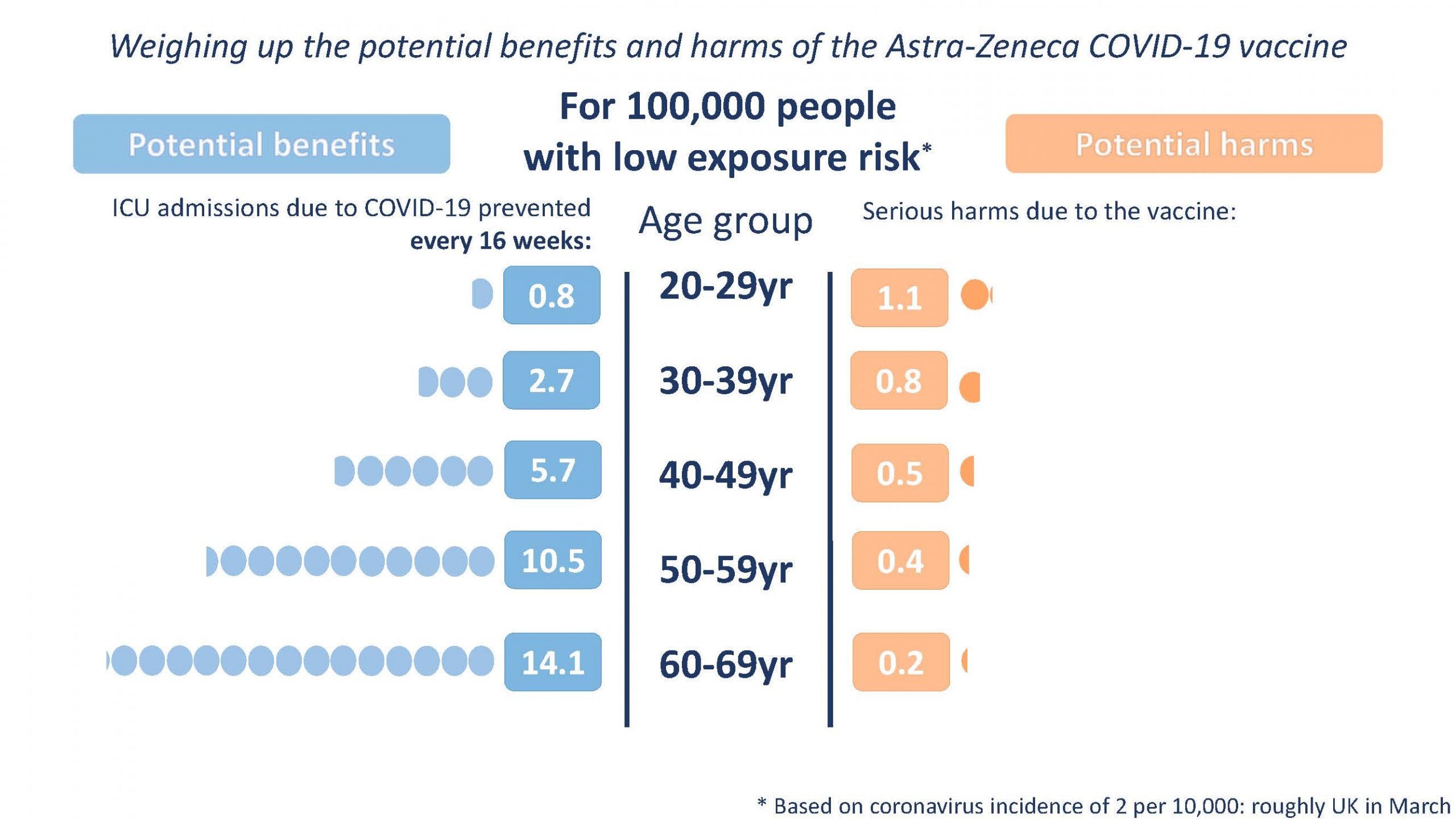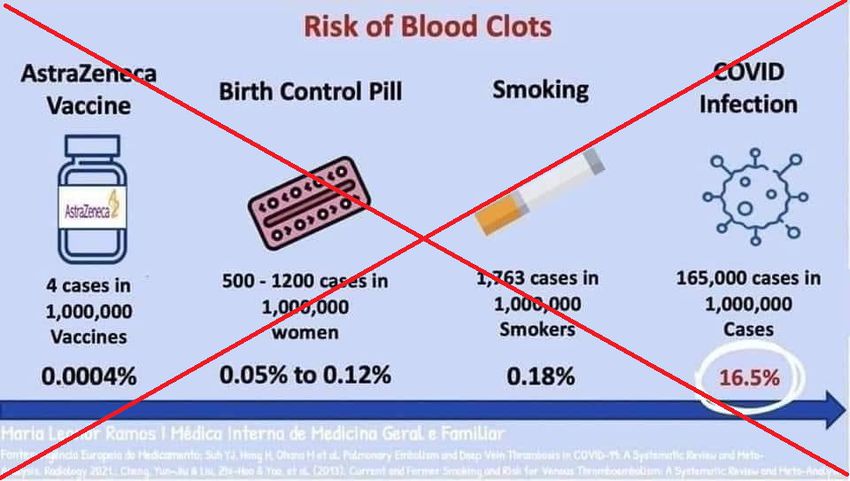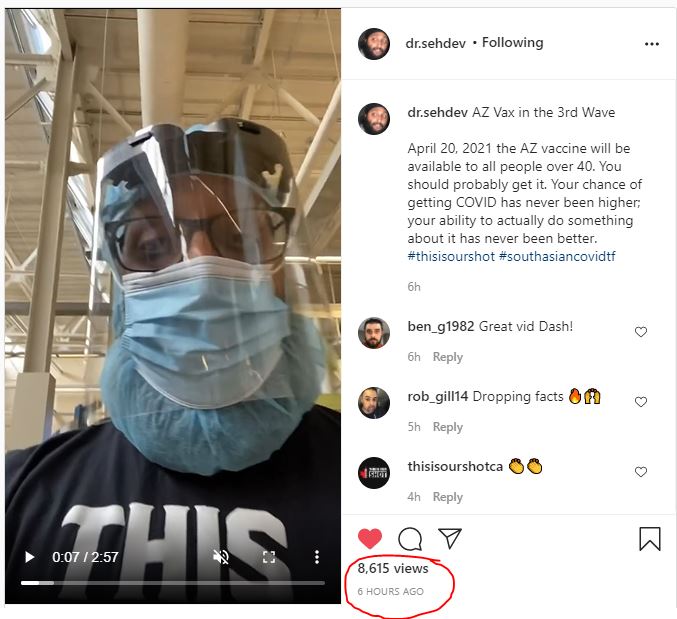
Understanding the blood clot issue behind the AstraZeneca vaccine and its safety
By: Dr. Menaka Pai and Sabina Vohra-Miller
The AstraZeneca vaccine and the rare but serious blood clots it’s associated with have been on everyone’s mind lately. That condition has been given the term Vaccine Induced Immune Thrombotic Thrombocytopenia or VIIT. As physicians, health advocates and science communicators, we are frustrated with the confusing discourse around AstraZeneca and the many misguided opinions on the topic. We see sensational posts from both sides of this discussion. Here is our more nuanced, balanced take using science:
Yes, there is a risk, but it’s a very small absolute risk
When we compare the risk of these rare kinds of blood clots against what we would normally see in the general population in a specific time period, there is a clear increase compared to the background rate. The European Medicines Agency discusses a risk of approximately 6.5 events per million doses. For Johnson & Johnson, we see 6 cases in 6.8 million doses, for an event rate of under 1 per million doses. In the Canadian context, the event rate appears to be 1 in 250,000 doses. We must keep in mind that these rates include all of the individuals who are eligible to receive the vaccine — which is why they differ between jurisdictions. But it is still important to note that the absolute risk for these events is low.
Let’s put this risk into perspective
There are few decisions we make in life that are “risk free.” For example, there are risks of serious events that can occur when driving, crossing the road, smoking, or even eating peanut butter for the first time. There is a risk of liver damage when you take acetaminophen with alcohol. Yet, I’m sure many people would feel comfortable popping a Tylenol before bed after having a few drinks. We take calculated and informed risks every day and are exposed to many unknown risks daily. Nearly everything we do is a balancing act between risk and benefit.
What does balancing risk and benefit look like?
Ontario is in the middle of a third wave, shaping up to be the most devastating one to date. We’ve had to build field hospitals in parking lots, fly ICU patients across the province, care for adult patients in pediatric ICUs, and re-deploy our finite number of healthcare workers to areas where they have not been trained to work. We are also beginning to cancel non-emergent care – which means at some point we will begin to defer life-saving cancer and cardiac surgeries. This past week, we lost 145 people to COVID, with thousands more infected.
When we look at the risks of COVID-19, we begin to appreciate that the benefits of getting vaccinated with AstraZeneca vaccine far outweigh the risks of serious adverse events, especially when community spread crosses a certain threshold. As of April 15, Ontario has a weekly case average of 199.9 per 100,000 people. Community spread is objectively high. This graph from the UK Winton Centre for Risk and Evidence Communication illustrates nicely how in a high covid exposure risk situation (defined as 20 cases per 10,000, for example, like Ontario right now), the benefits of the AstraZeneca vaccine far outweigh its risks.

The UK Winton Centre for Risk and Evidence Communication says the benefits of the AstraZeneca vaccine far outweigh its risks in a high COVID-19 exposure risk situation.
What about the risk to the individual?
Scientists measure population level risks, but for the average person, population risk is neither intuitive nor representative. For example, when we talk about the COVID-19 vaccine’s efficacy being 95 per cent, it does not mean that the average person has a 5 per cent chance of getting COVID. In fact, a given person’s individual risk can be higher or lower based on a multitude of individual factors. Similarly, when people say the risk of VITT is “only one in a million,” this could be higher or lower for an individual level. For example, the risk of VITT might be higher than one in a 250,000 doses in a young woman.
Misleading graphics that miscommunicate risk are not helping, they are harming
There are graphics being widely circulated that compare the risk of VITT – a very specific and rare event – to blood clots associated with other phenomena. Here is an example of one I found on twitter:
 The problem with this and graphics like this is that they compare apples to oranges. The type of blood clots you get from oral contraceptive pills are quite different from the blood clots associated with VITT, making it an unfair direct comparison. While COVID-19 infections carry a higher risk of blood clots than the vaccine, the percentage quoted in this graphic are in fact for those hospitalized with COVID-19; it does not capture the individual’s risk of first catching COVID-19. These comparisons are reductive; they dismiss and misrepresent concerns about vaccine associated clots and other kinds of clots. What happens when someone who is apprehensive realizes you’re trying to persuade them with misinformation? You lose their confidence and trust.
The problem with this and graphics like this is that they compare apples to oranges. The type of blood clots you get from oral contraceptive pills are quite different from the blood clots associated with VITT, making it an unfair direct comparison. While COVID-19 infections carry a higher risk of blood clots than the vaccine, the percentage quoted in this graphic are in fact for those hospitalized with COVID-19; it does not capture the individual’s risk of first catching COVID-19. These comparisons are reductive; they dismiss and misrepresent concerns about vaccine associated clots and other kinds of clots. What happens when someone who is apprehensive realizes you’re trying to persuade them with misinformation? You lose their confidence and trust.
Fears about side effects are legitimate and need to be met with compassion, not dismissal
Downplaying the concerns people have about medical conditions feels dismissive. It is dismissive. At this point in the pandemic, many of us are overwhelmed and frightened by the continued uncertainty around our health and wellbeing. Both vaccine hesitancy and vaccine demand are at their peak. It’s not uncommon for someone to be desperate to get a vaccine but terrified of it being the AstraZeneca vaccine. We need to take the time to understand their concerns and address them with respect and empathy. This means taking the time to explain the nuances and acknowledge that people are scared and overwhelmed.
It’s also extremely important that people understand why there is currently a pause in the use of the AstraZeneca vaccine if you are under 55. This decision, made by the National Advisory Committee on Immunization, did not concede that the vaccine is unsafe or that approvals were rushed. Rather, it shows how seriously Canadian regulators and public health officials are taking even the rarest of side effects, taking swift and transparent action at the first sign of an adverse event.
The pause allows us to investigate serious clotting events further to understand the true incidence, factors that might increase susceptibility, and importantly, increase awareness among the public and health care providers. This ensures anyone who suffers a clot is quickly diagnosed and appropriately treated.
The AstraZeneca vaccine and the Johnson & Johnson vaccine are highly effective vaccines that will prevent you from having severe illness, hospitalization and death due to COVID-19. Due diligence is being done on every single vaccine in Canada. We implore you to take the first vaccine that is offered to you, and encourage those you love to as well.
Dr Menaka Pai is an Associate Professor of Medicine at McMaster University, and a hematologist and thrombosis medicine physician at Hamilton Health Sciences. Follow her at: @MPaiMD
Sabina Vohra-Miller is the co-founder of the Toronto-based Vohra Miller Foundation, which aims to make health care equitable and accessible for all. She is also the founder of Unambiguous Science. Follow her at @SabiVM.



